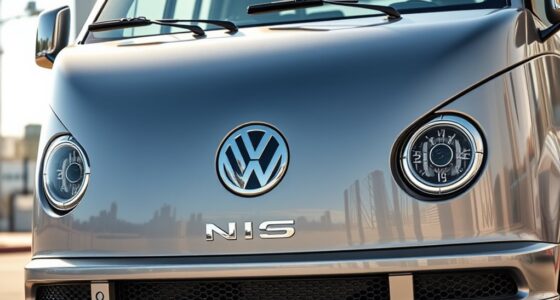The VW Microbus became a powerful symbol of freedom, counterculture, and personal expression, especially during the 1960s. Its iconic design and association with music, activism, and community made it a cultural icon that influenced attitudes and lifestyles worldwide. The vehicle’s rebellious spirit and adaptable style continue to inspire modern reinterpretations, blending nostalgia with innovation. If you want to discover how its legacy shapes today’s lifestyle and design trends, there’s more to explore.
Key Takeaways
- The VW Microbus became an iconic symbol of the 1960s counterculture and hippie movement, representing freedom and rebellion.
- Its distinctive design and customizations fostered a culture of personal expression and artistic creativity.
- The Microbus supported communal living and activism, often serving as mobile platforms for protests and social movements.
- Its cultural symbolism persists through vintage restorations, memorabilia, and its frequent portrayal in media and pop culture.
- The vehicle’s association with adventure and alternative lifestyles has cemented its status as a lasting icon of freedom and individuality.
Origins and Early Development of the VW Microbus
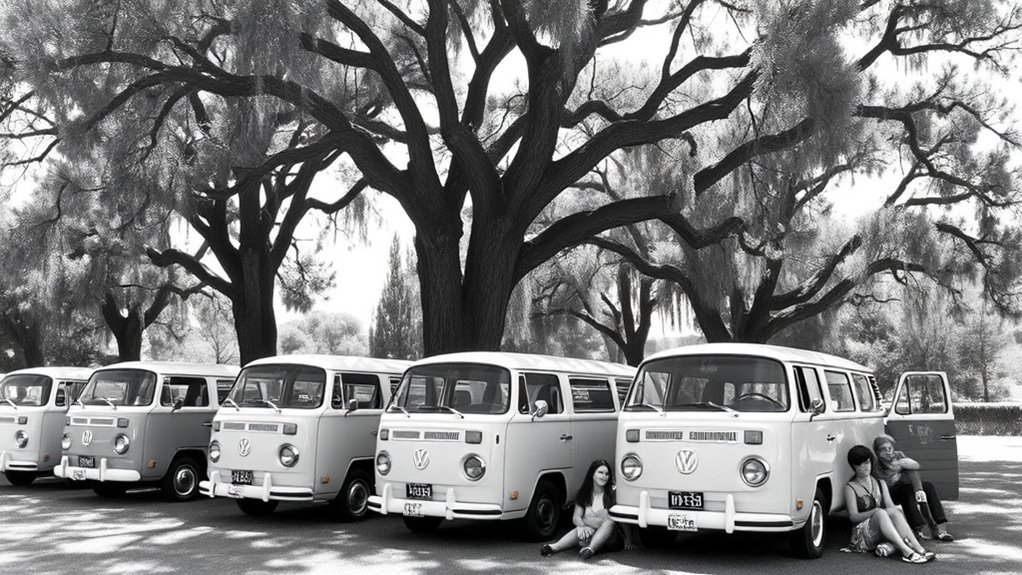
The origins of the Volkswagen Microbus trace back to the late 1940s when Dutch VW importer Ben Pon sketched the first van concept after seeing a flatbed parts-hauler based on the Type I chassis. In 1947, he imagined a vehicle that could carry cargo and passengers, leading to the development of the Type 29 prototype in 1949.
This prototype used a Beetle chassis and a ladder frame, introducing an innovative design with rear-wheel drive and a spacious interior. The Microbus debuted at the 1949 Geneva Motor Show and officially went into production on March 8, 1950.
Initially offered as a panel van and a passenger-friendly Kombi, it combined practicality with versatility, setting the stage for its global impact and long-lasting legacy.
The Microbus as a Symbol of 1960s Counterculture
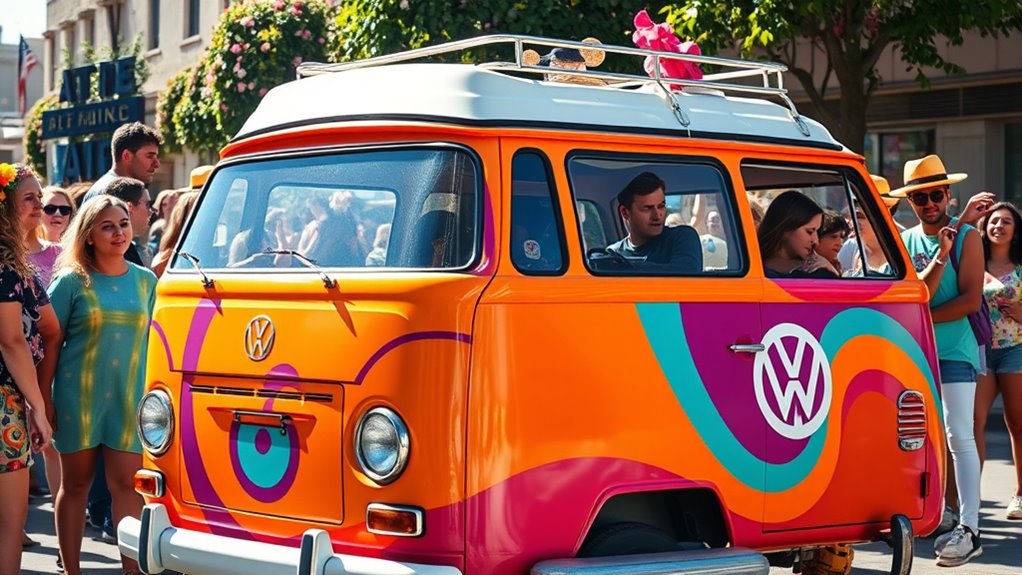
As the VW Microbus gained popularity in the 1960s, it became more than just a practical vehicle; it transformed into a powerful symbol of the counterculture movement. You’d see it at concerts, protests, and gatherings, embodying a lifestyle that rejected mainstream American values. Customizations with peace signs and psychedelic colors made it a “hippie bus,” while its spacious interior supported communal living and activism. Its presence in psychedelic rock music and art reinforced its rebellious identity. The Microbus served as a mobile platform for anti-war protests and social change, reflecting the era’s ideals of peace and unity. Its iconic status grew as a symbol of freedom, creativity, and resistance, capturing the spirit of 1960s counterculture. Engaging with the history of this vehicle can deepen our understanding of cultural symbolism and its enduring influence.
Design Features and Practicality That Fostered Personal Expression

Design features of the VW Microbus invite owners to express their individuality and creativity. Its retro aesthetic appeals to those seeking nonconformity, while the customizable options—paint and interior designs—encourage personal touches. The spacious, open interior provides endless opportunities for creative arrangements, whether as mobile homes or art spaces. The rear engine layout creates front space for diverse configurations, enhancing versatility. Its iconic shape symbolizes freedom and adventure, resonating with personal expression. Practicality features like large capacity, affordability, and durability make it accessible and reliable for extended use. Modern innovations, such as the ID. Buzz, blend nostalgic design with advanced tech, offering customizable interiors and eco-friendly performance. Incorporating natural materials and vintage-inspired textiles can further enhance the authentic and personalized vibe of the Microbus, allowing owners to reflect their unique style. Additionally, the use of sustainable materials aligns with current environmental values and appeals to eco-conscious consumers. The integration of vintage textiles and eco-friendly components not only supports sustainability but also amplifies the Microbus’s nostalgic appeal. Together, these design and practical features foster a unique platform for owners to showcase their personality and creativity.
The Microbus in Popular Media and Its Cultural Significance
The VW Microbus’s distinctive shape and cultural associations have cemented its status as an icon in popular media. You’ve likely seen it symbolize counterculture movements in films and TV shows, representing freedom and rebellion. Its appearance in “Futurama” and music documentaries about Woodstock underscores its cult status. During the 1960s, the Microbus became a visual shorthand for social upheaval, often decorated with psychedelic art, peace signs, and flowers. It also appears in vintage advertisements honoring icons like Jerry Garcia, highlighting its cultural influence. Photos of hippies with the Microbus have become enduring symbols of the era. Today, the Microbus continues to evoke nostalgia, with replicas, memorabilia, and social media imagery celebrating its role as a cultural and artistic icon. The Microbus’s cultural symbolism has been reinforced by its frequent portrayal in media as a symbol of freedom and counterculture. Additionally, its popularity in collectibles and social media keeps its legacy alive among new generations of enthusiasts. The enduring cultural significance of the Microbus reflects its status not just as a vehicle, but as a powerful emblem of a transformative era in history. Its status as a nostalgic icon is further supported by the continued interest in vintage models and restoration projects, which preserve its cultural legacy for future generations.
Evolution and Modern Reinventions of the Classic Model
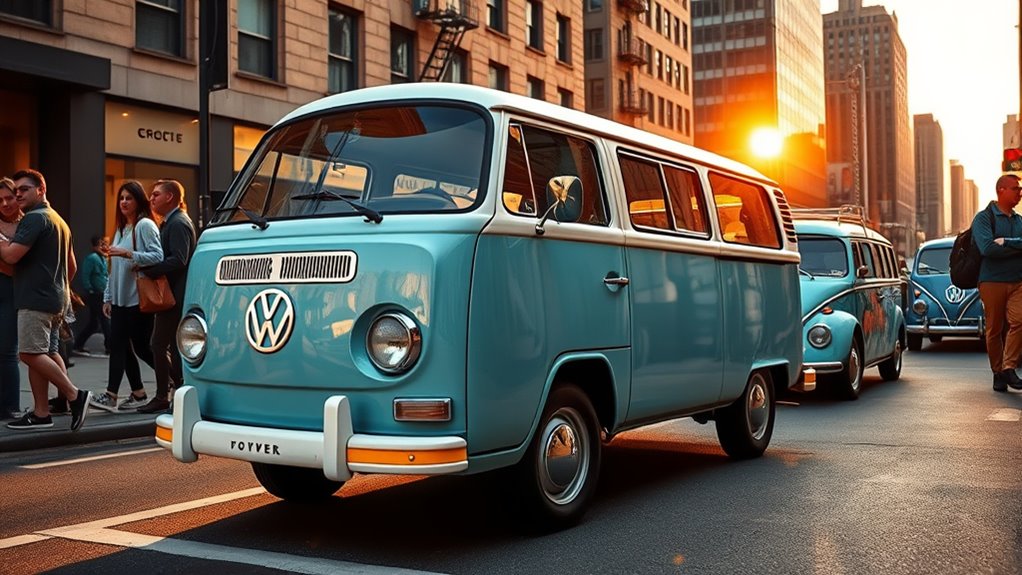
Over the years, the VW Microbus has undergone significant evolution, blending its iconic design with modern innovations. Starting with the original T1 model, it became a symbol of counterculture, with design improvements like a better drag coefficient and new variants. The introduction of lightweight design in newer models enhanced its performance and efficiency. The second-generation T2 offered a more powerful engine, while subsequent models introduced water-cooled engines, modern body styles, and enhanced efficiency. In recent years, VW reimagined the Microbus with concepts like the 2001 Microbus and 2011 Bulli, which showcased electric power and retro styling. The 2022 ID.Buzz embodies this evolution, combining vintage aesthetics with cutting-edge technology and electric propulsion. These reinventions preserve the Microbus’s nostalgic charm while aligning with contemporary demands for sustainability and innovation, supported by advancements in sound design that improve the overall user experience. Additionally, ongoing market analysis has helped shape these modern interpretations to meet current consumer preferences, reflecting the importance of understanding consumer trends in automotive design.
The Microbus’s Enduring Legacy in Art and Lifestyle Movements
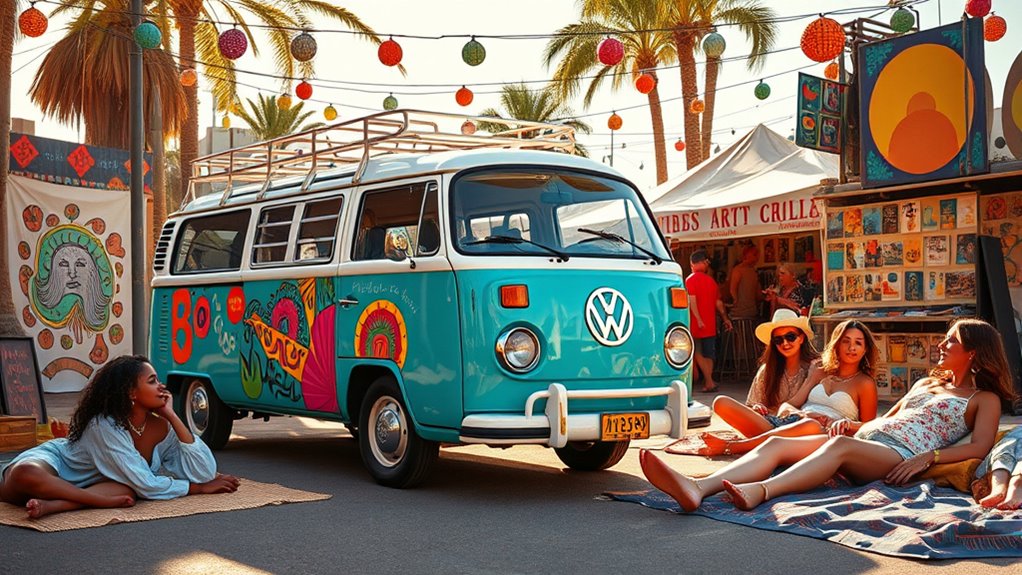
Since its rise to fame in the 1960s and 1970s, the VW Microbus has become a powerful symbol of freedom, individuality, and countercultural values. Its unique design inspired artists, photographers, and writers to capture its vibrant spirit, turning the Microbus into a canvas for self-expression. Custom-painted vans with bold patterns and symbols reflected the era’s emphasis on visual identity and creativity. Its presence in films and art reinforced its role as a symbol of alternative lifestyles. The Microbus’s association with music festivals like Woodstock elevated its cultural significance, embodying community and adventure. Today, it continues to inspire new generations, representing nonconformity, exploration, and the pursuit of freedom—values that keep its legacy alive in art and lifestyle movements. Additionally, the Microbus’s enduring influence is supported by its integration into holistic wellness themes, symbolizing a lifestyle of openness and personal growth that resonates with modern communities. Its nostalgic appeal has also contributed to its status as an icon in collectible vehicles, inspiring restoration projects and vintage markets. The vehicle’s cultural symbolism has helped it remain relevant in contemporary pop culture and lifestyle trends. Furthermore, its iconic silhouette and design have become a branding element for various lifestyle brands seeking to embody its spirit of adventure.
The Future of the Microbus and Its Continued Cultural Relevance
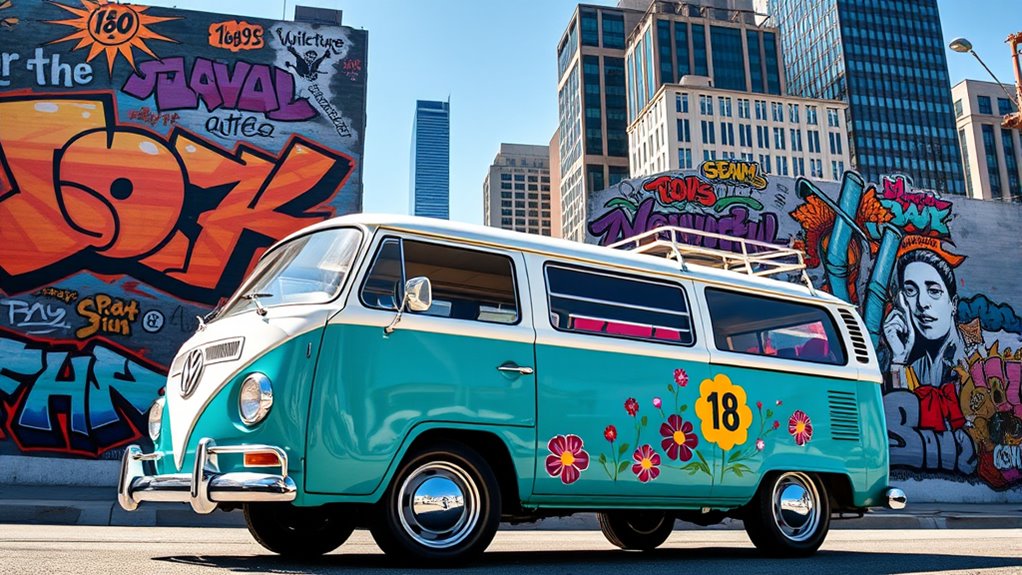
As the VW Microbus continues to symbolize freedom and cultural rebellion, its modern revival with the 2025 ID. Buzz keeps that spirit alive. This electric version blends nostalgic design—boxy shape and large windows—with cutting-edge technology, appealing to both old fans and new buyers. Its sustainable electric powertrain, built on Volkswagen’s MEB platform, offers up to 234 miles of range and strong performance with dual motors producing up to 335 horsepower. The ID. Buzz’s innovative features, like 360-degree cameras and premium audio, enhance the driving experience. Additionally, the redesign emphasizes environmental sustainability, reflecting the growing importance of eco-friendly transportation options, similar to the health benefits seen in juice cleansing practices. As the popularity of eco-conscious vehicles grows, understanding regional resources and local market trends can help consumers make informed choices about sustainable transportation, which increasingly influences modern automotive design and consumer preferences.
Frequently Asked Questions
How Did the VW Microbus Influence Modern Vehicle Customization Trends?
You see, the VW Microbus changed how people approach vehicle customization by offering a versatile, easily modifiable design. Its modular interior and iconic look inspired modern vehicles to include customizable options, like configurable seating and personalized aesthetics.
You now notice more vehicles emphasizing personalization, practicality, and unique styles, all rooted in the Microbus’s influence. This trend encourages owners to express themselves and adapt their vehicles to fit their lifestyles.
What Role Did the Microbus Play in Environmental Activism?
Think of the Microbus as a symbol of freedom, much like the hippie movement of the 1960s. You see, it didn’t directly lead environmental activism but embodied a lifestyle that cherished nature and exploration.
Its iconic presence inspired many to embrace a nomadic, eco-conscious way of life. Today, Volkswagen’s electric ID. Buzz revives that spirit, aligning with modern environmental goals and sustainable transportation.
How Has the Microbus Impacted Global Travel and Tourism Cultures?
You see how the Microbus transformed travel and tourism cultures worldwide. It inspired the van life movement, emphasizing small-space living and eco-friendly travel.
You might notice its influence in modern electric vans and customized vehicles, fostering community and sustainability. Its legacy of freedom and individuality continues to shape travel trends, encouraging you to explore the world in a versatile, personalized way that values environmental consciousness and cultural expression.
Are There Notable Artists or Musicians Who Adopted the Microbus as a Symbol?
You might think only hippies loved the Microbus, but many artists and musicians adopted it as a symbol of freedom and creativity. Bands like the Grateful Dead relied on Microbuses for tours, making it a moving icon of counterculture.
Surfers and California musicians decorated theirs with psychedelic art, turning them into rolling art galleries. Its widespread use in music and art cemented the Microbus as a symbol of artistic expression and rebellion.
How Does the Microbus Continue to Inspire Contemporary Design and Lifestyle Brands?
You see, the Microbus continues to inspire modern design and lifestyle brands by blending vintage charm with contemporary trends. Its iconic look influences car designs like Volkswagen’s ID. Buzz, merging retro features with electric technology.
Lifestyle brands adopt its bold colors and adventurous spirit in clothing, outdoor gear, and marketing. You can feel its legacy in products that evoke freedom, creativity, and a nostalgic sense of wanderlust, shaping today’s aesthetic and cultural expressions.
Conclusion
You’ve seen how the VW Microbus became a symbol of freedom and self-expression, shaping a generation’s identity. Did you know that over 12 million Microbuses were produced worldwide? That’s a demonstration to its lasting impact. As it evolves and inspires new designs, the Microbus continues to embody a spirit of adventure and community. Its cultural legacy reminds us that sometimes, a simple van can change the world around it.


